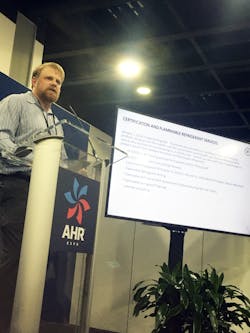Clock Ticking on Product Certifications Related to A2L Refrigerants

During a Monday morning educational session in Theater A at the 2023 AHR Expo, Craig Grider, regional chief engineer for Intertek, provide a no-holds-barred description of what will be required by manufacturers to meet the requirements for equipment that will use A2L mildly flammable refrigerants.
After January 1, 2024, HVAC product standards UL 1995/CSA C2.2 No.236 and UL 484, CSA C22.2 No. 117, UL 474 or CSA C22.2 No. 92 will be superseded by the new North American HVAC standard UL/CSA 60335-2-40.
In California, the standard will require that new refrigerants for the following must have a global warming potential (GWP) of 750 or less:
- 2023: New room air conditioning and dehumidification appliances.
- 2024: New chillers for air conditioning.
- 2025: New residential and stationary commercial air conditioning appliances.
- 2026: New VRF appliances.
In accordance with the American Innovation and Manufacturing Act
EPA published a proposed Rule on December 15, 2022. The comment period closed at the end of January 2023. The goal is an 85 percent phasedown of all hydrofluorocarbon refrigerants (HFCs) by 2036. For HVAC products the proposed GWP limit is 700.
Other AIM Act Proposed Deadlines
- January 1, 2025: chillers; residential and light commercial HVAC and heat pumps; and residential dehumidifiers.
- January 1, 2026: VRF systems.
What’s Available?
Grider said the majority of currently available Class A1 refrigerants exceed the GWP limits set by CARB and the proposed limits of the AIM Act.
The list of available alternatives approved by the Environmental Protection Agency under the SNAP ruling is limited but the options are growing. However, the best alternatives are flammable, though only mildly so. But that still puts them outside of Certification legacy standards for heating and cooling equipment, room air conditioners and dehumidifiers, which means A2L refrigerants must be utilized.
Grider said original equipment manufacturers should expect certifications to take longer under 60335-2-40.
On average, the lead times from start to completion take a minimum of three weeks to complete all required testing, Grider said. If electronic controls are utilized as safety protections, the evaluations can add MONTHS to the process, depending on the level of complexity in the controls and the required cyclic testing. If unlisted components are used in the construction, additional time will be required to evaluate and test for use in the HVAC appliance.
Grider described Intertek’s services for certification and flammable refrigerant services. To prevent any disruptions in certification for existing products being placed on the market, Intertek recommends OEMs work with their Account Representative NOW to discuss plans for transitioning to UL-50335-2-40. Intertek can work with OEMs in several ways to prepare them for the standard transition. This includes:
- UL 60335-2-40 training seminar for engineers and/or testing staff.
- UL 60335-2-40 Preliminary Design Reviews
- Concurrent Evaluation /Testing for UL 60335-2-40 with UL 1995/484/474 projects (future reference)
- Flammable Refrigerant Risk Assessment of Manufacturing/Test Lab Facility
- Flammable Refrigerant Training
- Intertek consulting.
Visit Intertek online at Intertek.com/hvacr. Craig Grider can be reached at [email protected].
About the Author
Terry McIver
Content Director - CB
As director of content for Contracting Business, he produces daily content and feature articles for CB's 38,000 print subscribers and many more Internet visitors. He has written hundreds, if not two or three, pieces of news, features and contractor profile articles for CB's audience of quality HVACR contractors. He can also be found covering HVACR industry events or visiting with manufacturers and contractors. He also has significant experience in trade show planning.